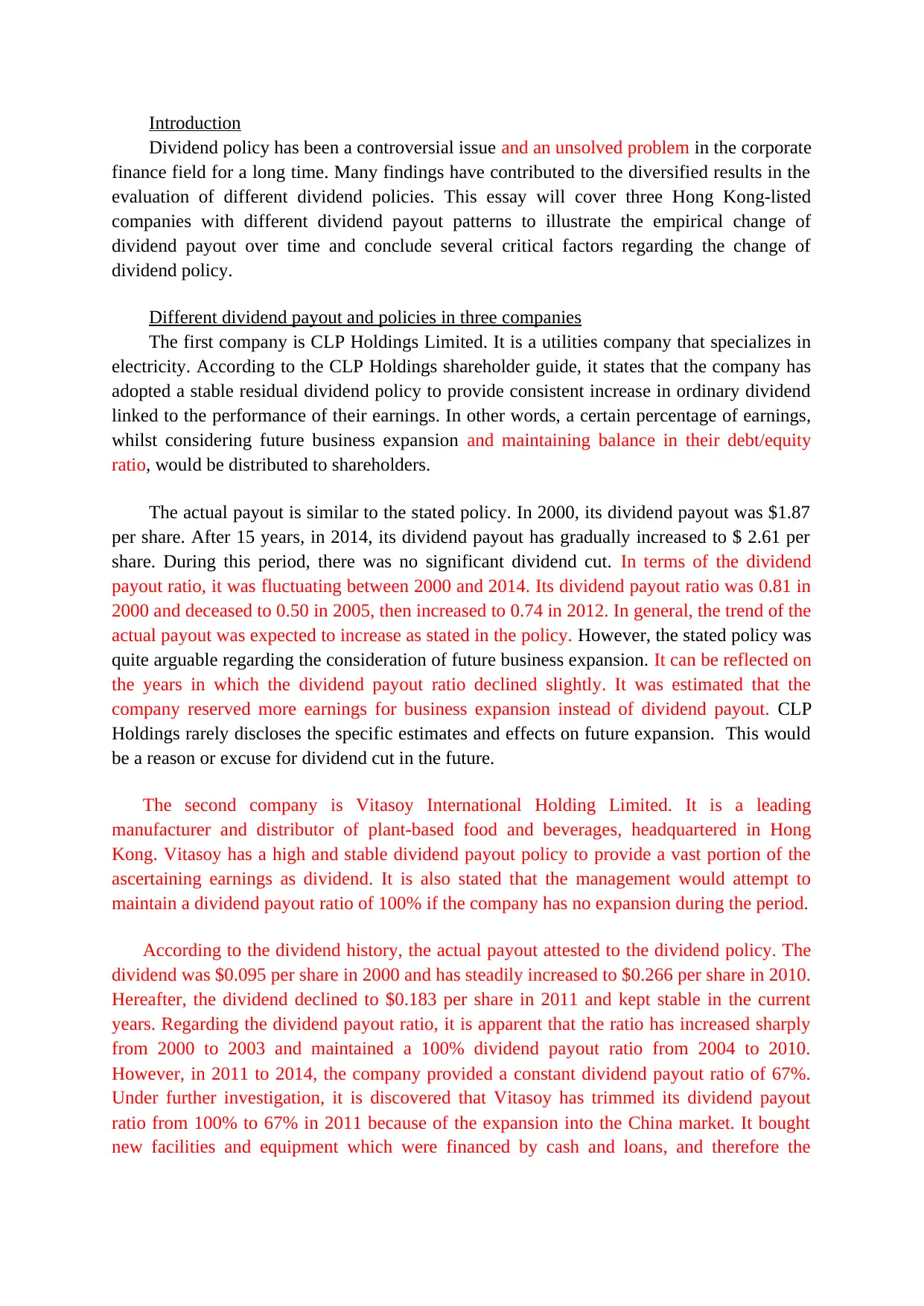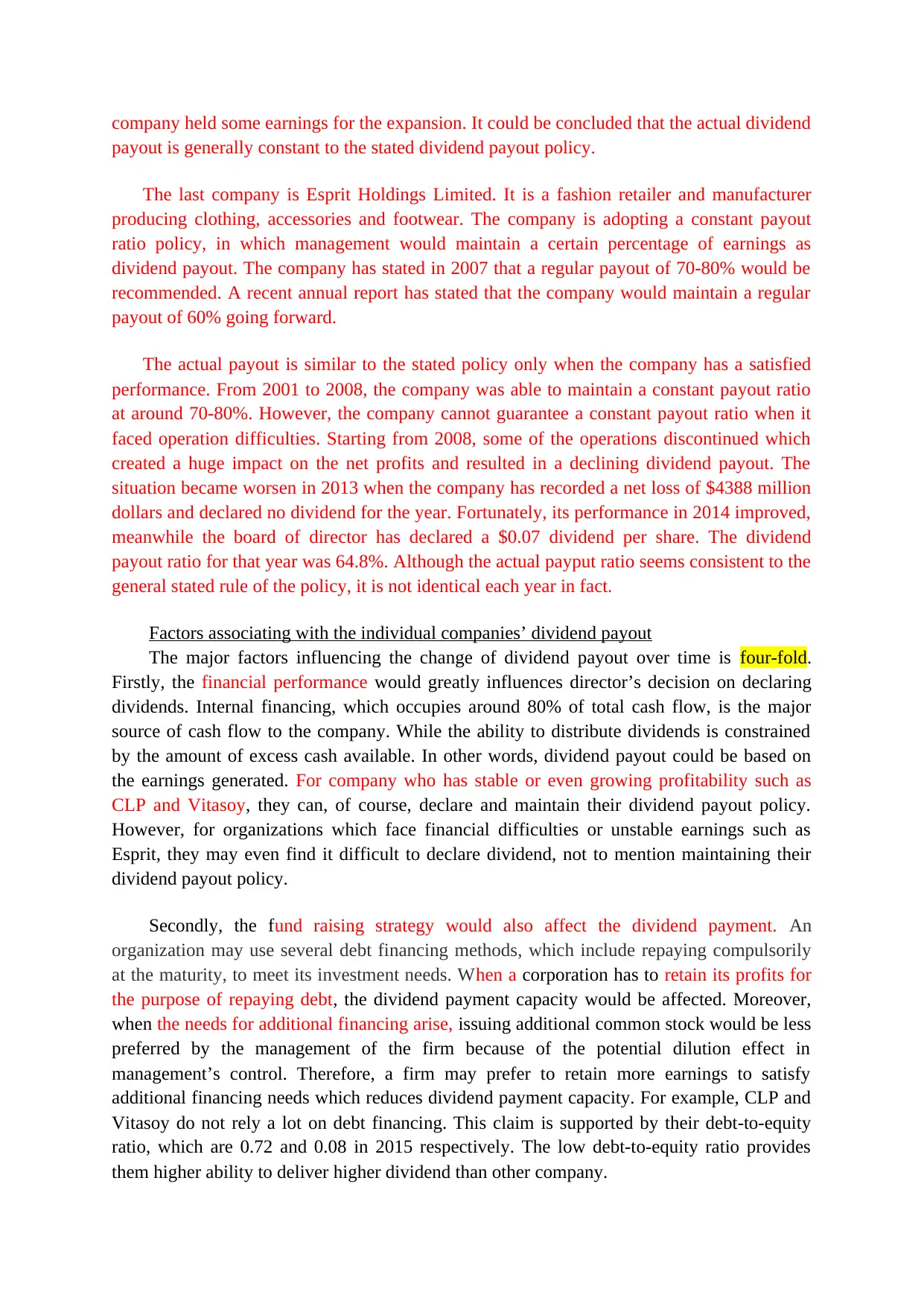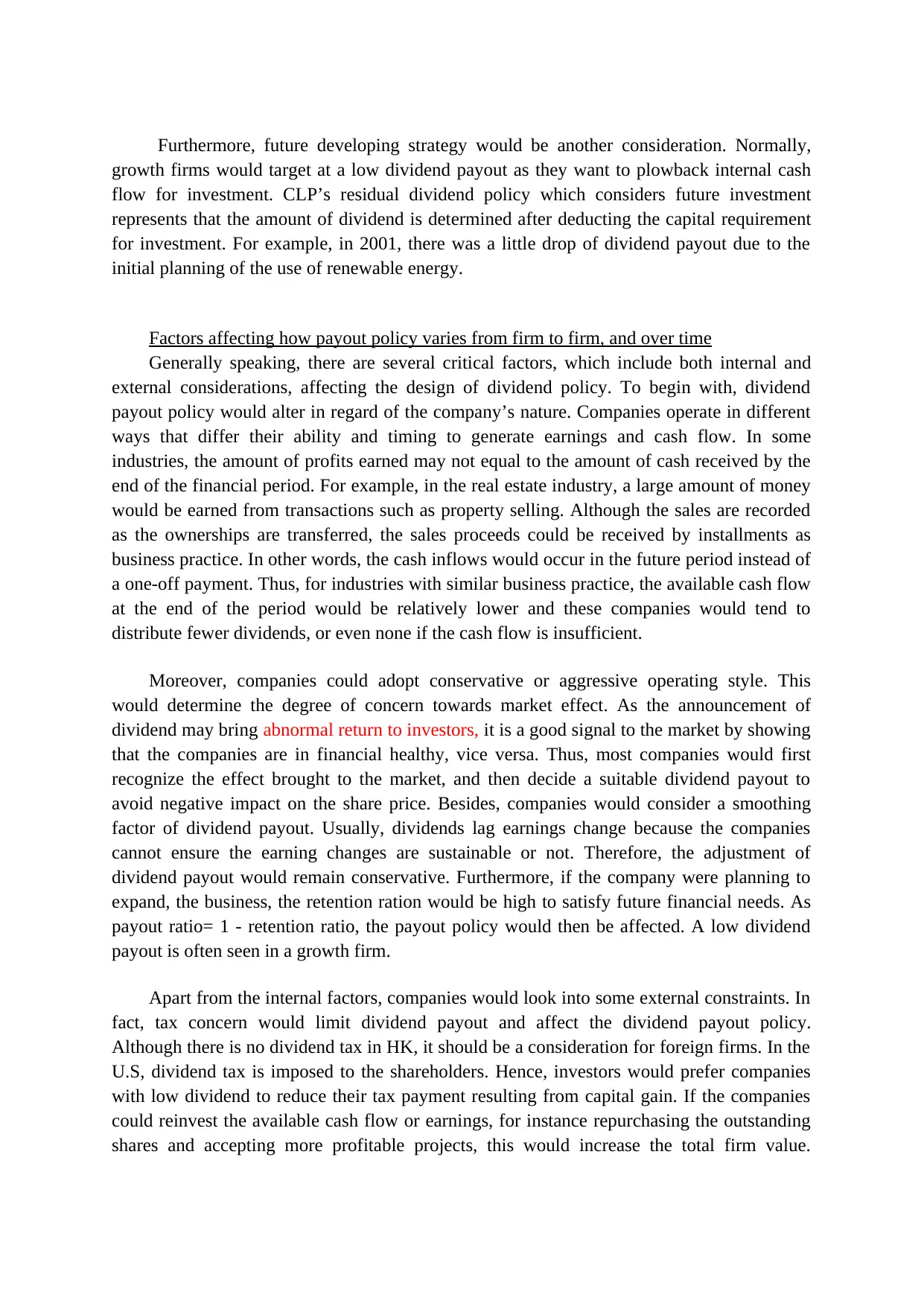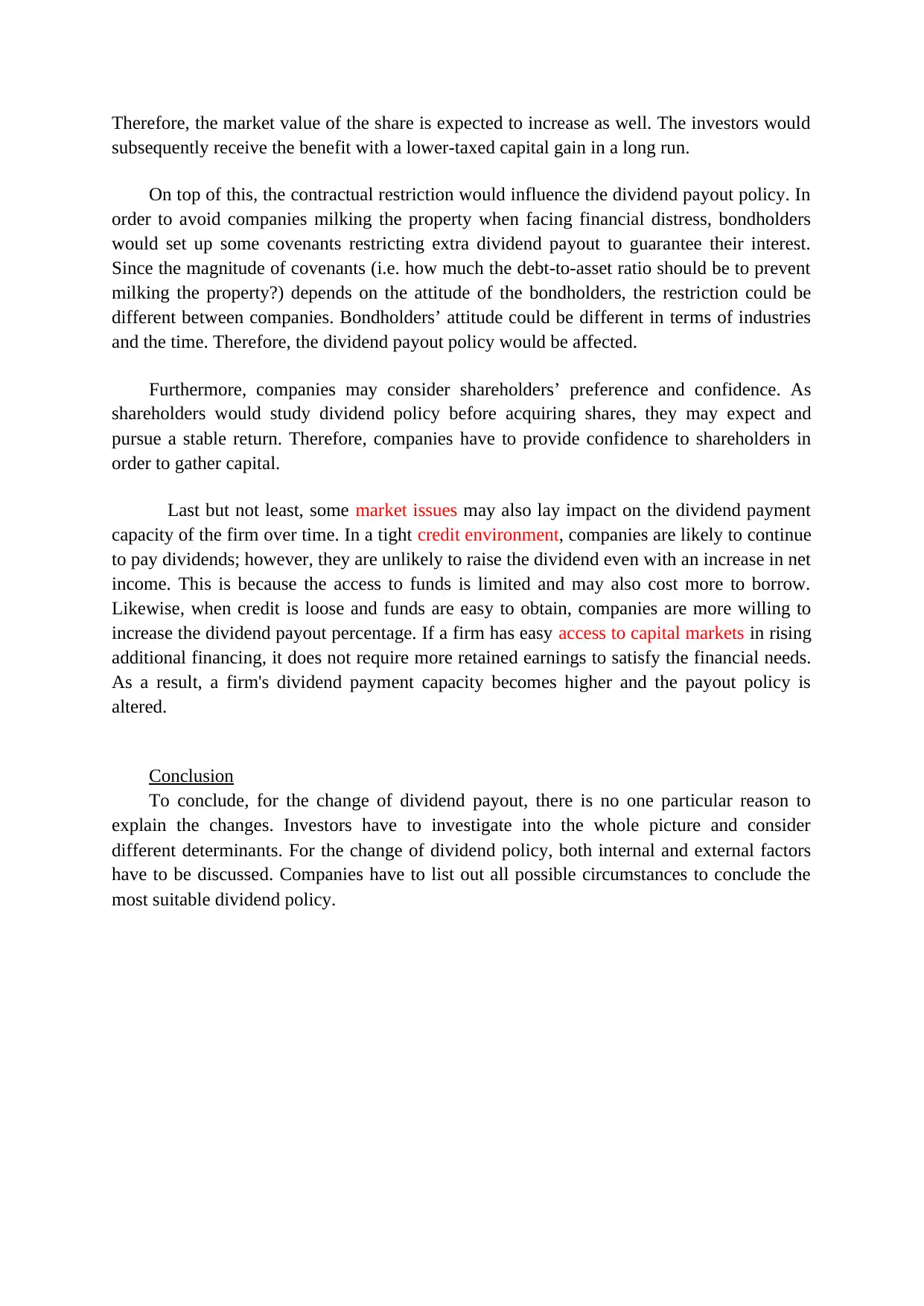Factors Influencing Dividend Payout Ratios
VerifiedAdded on 2019/09/20
|4
|2154
|215
Report
AI Summary
The article discusses the factors that influence a company's dividend payout policy. It highlights four major factors: financial performance, fund-raising strategy, future developing strategy, and market issues. The financial performance of a company plays a significant role in determining its ability to declare dividends. Fund-raising strategies, such as debt financing, can also affect a company's dividend payment capacity. Future developing strategies, including growth-oriented companies that plow back internal cash flow for investment, can also influence dividend payout policies. Additionally, market issues, such as credit environment and access to capital markets, can also impact a company's ability to declare dividends. The article concludes that there is no single reason to explain the changes in a company's dividend payout policy, but rather a combination of internal and external factors.
Contribute Materials
Your contribution can guide someone’s learning journey. Share your
documents today.

Introduction
Dividend policy has been a controversial issue and an unsolved problem in the corporate
finance field for a long time. Many findings have contributed to the diversified results in the
evaluation of different dividend policies. This essay will cover three Hong Kong-listed
companies with different dividend payout patterns to illustrate the empirical change of
dividend payout over time and conclude several critical factors regarding the change of
dividend policy.
Different dividend payout and policies in three companies
The first company is CLP Holdings Limited. It is a utilities company that specializes in
electricity. According to the CLP Holdings shareholder guide, it states that the company has
adopted a stable residual dividend policy to provide consistent increase in ordinary dividend
linked to the performance of their earnings. In other words, a certain percentage of earnings,
whilst considering future business expansion and maintaining balance in their debt/equity
ratio, would be distributed to shareholders.
The actual payout is similar to the stated policy. In 2000, its dividend payout was $1.87
per share. After 15 years, in 2014, its dividend payout has gradually increased to $ 2.61 per
share. During this period, there was no significant dividend cut. In terms of the dividend
payout ratio, it was fluctuating between 2000 and 2014. Its dividend payout ratio was 0.81 in
2000 and deceased to 0.50 in 2005, then increased to 0.74 in 2012. In general, the trend of the
actual payout was expected to increase as stated in the policy. However, the stated policy was
quite arguable regarding the consideration of future business expansion. It can be reflected on
the years in which the dividend payout ratio declined slightly. It was estimated that the
company reserved more earnings for business expansion instead of dividend payout. CLP
Holdings rarely discloses the specific estimates and effects on future expansion. This would
be a reason or excuse for dividend cut in the future.
The second company is Vitasoy International Holding Limited. It is a leading
manufacturer and distributor of plant-based food and beverages, headquartered in Hong
Kong. Vitasoy has a high and stable dividend payout policy to provide a vast portion of the
ascertaining earnings as dividend. It is also stated that the management would attempt to
maintain a dividend payout ratio of 100% if the company has no expansion during the period.
According to the dividend history, the actual payout attested to the dividend policy. The
dividend was $0.095 per share in 2000 and has steadily increased to $0.266 per share in 2010.
Hereafter, the dividend declined to $0.183 per share in 2011 and kept stable in the current
years. Regarding the dividend payout ratio, it is apparent that the ratio has increased sharply
from 2000 to 2003 and maintained a 100% dividend payout ratio from 2004 to 2010.
However, in 2011 to 2014, the company provided a constant dividend payout ratio of 67%.
Under further investigation, it is discovered that Vitasoy has trimmed its dividend payout
ratio from 100% to 67% in 2011 because of the expansion into the China market. It bought
new facilities and equipment which were financed by cash and loans, and therefore the
Dividend policy has been a controversial issue and an unsolved problem in the corporate
finance field for a long time. Many findings have contributed to the diversified results in the
evaluation of different dividend policies. This essay will cover three Hong Kong-listed
companies with different dividend payout patterns to illustrate the empirical change of
dividend payout over time and conclude several critical factors regarding the change of
dividend policy.
Different dividend payout and policies in three companies
The first company is CLP Holdings Limited. It is a utilities company that specializes in
electricity. According to the CLP Holdings shareholder guide, it states that the company has
adopted a stable residual dividend policy to provide consistent increase in ordinary dividend
linked to the performance of their earnings. In other words, a certain percentage of earnings,
whilst considering future business expansion and maintaining balance in their debt/equity
ratio, would be distributed to shareholders.
The actual payout is similar to the stated policy. In 2000, its dividend payout was $1.87
per share. After 15 years, in 2014, its dividend payout has gradually increased to $ 2.61 per
share. During this period, there was no significant dividend cut. In terms of the dividend
payout ratio, it was fluctuating between 2000 and 2014. Its dividend payout ratio was 0.81 in
2000 and deceased to 0.50 in 2005, then increased to 0.74 in 2012. In general, the trend of the
actual payout was expected to increase as stated in the policy. However, the stated policy was
quite arguable regarding the consideration of future business expansion. It can be reflected on
the years in which the dividend payout ratio declined slightly. It was estimated that the
company reserved more earnings for business expansion instead of dividend payout. CLP
Holdings rarely discloses the specific estimates and effects on future expansion. This would
be a reason or excuse for dividend cut in the future.
The second company is Vitasoy International Holding Limited. It is a leading
manufacturer and distributor of plant-based food and beverages, headquartered in Hong
Kong. Vitasoy has a high and stable dividend payout policy to provide a vast portion of the
ascertaining earnings as dividend. It is also stated that the management would attempt to
maintain a dividend payout ratio of 100% if the company has no expansion during the period.
According to the dividend history, the actual payout attested to the dividend policy. The
dividend was $0.095 per share in 2000 and has steadily increased to $0.266 per share in 2010.
Hereafter, the dividend declined to $0.183 per share in 2011 and kept stable in the current
years. Regarding the dividend payout ratio, it is apparent that the ratio has increased sharply
from 2000 to 2003 and maintained a 100% dividend payout ratio from 2004 to 2010.
However, in 2011 to 2014, the company provided a constant dividend payout ratio of 67%.
Under further investigation, it is discovered that Vitasoy has trimmed its dividend payout
ratio from 100% to 67% in 2011 because of the expansion into the China market. It bought
new facilities and equipment which were financed by cash and loans, and therefore the
Secure Best Marks with AI Grader
Need help grading? Try our AI Grader for instant feedback on your assignments.

company held some earnings for the expansion. It could be concluded that the actual dividend
payout is generally constant to the stated dividend payout policy.
The last company is Esprit Holdings Limited. It is a fashion retailer and manufacturer
producing clothing, accessories and footwear. The company is adopting a constant payout
ratio policy, in which management would maintain a certain percentage of earnings as
dividend payout. The company has stated in 2007 that a regular payout of 70-80% would be
recommended. A recent annual report has stated that the company would maintain a regular
payout of 60% going forward.
The actual payout is similar to the stated policy only when the company has a satisfied
performance. From 2001 to 2008, the company was able to maintain a constant payout ratio
at around 70-80%. However, the company cannot guarantee a constant payout ratio when it
faced operation difficulties. Starting from 2008, some of the operations discontinued which
created a huge impact on the net profits and resulted in a declining dividend payout. The
situation became worsen in 2013 when the company has recorded a net loss of $4388 million
dollars and declared no dividend for the year. Fortunately, its performance in 2014 improved,
meanwhile the board of director has declared a $0.07 dividend per share. The dividend
payout ratio for that year was 64.8%. Although the actual payput ratio seems consistent to the
general stated rule of the policy, it is not identical each year in fact.
Factors associating with the individual companies’ dividend payout
The major factors influencing the change of dividend payout over time is four-fold.
Firstly, the financial performance would greatly influences director’s decision on declaring
dividends. Internal financing, which occupies around 80% of total cash flow, is the major
source of cash flow to the company. While the ability to distribute dividends is constrained
by the amount of excess cash available. In other words, dividend payout could be based on
the earnings generated. For company who has stable or even growing profitability such as
CLP and Vitasoy, they can, of course, declare and maintain their dividend payout policy.
However, for organizations which face financial difficulties or unstable earnings such as
Esprit, they may even find it difficult to declare dividend, not to mention maintaining their
dividend payout policy.
Secondly, the fund raising strategy would also affect the dividend payment. An
organization may use several debt financing methods, which include repaying compulsorily
at the maturity, to meet its investment needs. When a corporation has to retain its profits for
the purpose of repaying debt, the dividend payment capacity would be affected. Moreover,
when the needs for additional financing arise, issuing additional common stock would be less
preferred by the management of the firm because of the potential dilution effect in
management’s control. Therefore, a firm may prefer to retain more earnings to satisfy
additional financing needs which reduces dividend payment capacity. For example, CLP and
Vitasoy do not rely a lot on debt financing. This claim is supported by their debt-to-equity
ratio, which are 0.72 and 0.08 in 2015 respectively. The low debt-to-equity ratio provides
them higher ability to deliver higher dividend than other company.
payout is generally constant to the stated dividend payout policy.
The last company is Esprit Holdings Limited. It is a fashion retailer and manufacturer
producing clothing, accessories and footwear. The company is adopting a constant payout
ratio policy, in which management would maintain a certain percentage of earnings as
dividend payout. The company has stated in 2007 that a regular payout of 70-80% would be
recommended. A recent annual report has stated that the company would maintain a regular
payout of 60% going forward.
The actual payout is similar to the stated policy only when the company has a satisfied
performance. From 2001 to 2008, the company was able to maintain a constant payout ratio
at around 70-80%. However, the company cannot guarantee a constant payout ratio when it
faced operation difficulties. Starting from 2008, some of the operations discontinued which
created a huge impact on the net profits and resulted in a declining dividend payout. The
situation became worsen in 2013 when the company has recorded a net loss of $4388 million
dollars and declared no dividend for the year. Fortunately, its performance in 2014 improved,
meanwhile the board of director has declared a $0.07 dividend per share. The dividend
payout ratio for that year was 64.8%. Although the actual payput ratio seems consistent to the
general stated rule of the policy, it is not identical each year in fact.
Factors associating with the individual companies’ dividend payout
The major factors influencing the change of dividend payout over time is four-fold.
Firstly, the financial performance would greatly influences director’s decision on declaring
dividends. Internal financing, which occupies around 80% of total cash flow, is the major
source of cash flow to the company. While the ability to distribute dividends is constrained
by the amount of excess cash available. In other words, dividend payout could be based on
the earnings generated. For company who has stable or even growing profitability such as
CLP and Vitasoy, they can, of course, declare and maintain their dividend payout policy.
However, for organizations which face financial difficulties or unstable earnings such as
Esprit, they may even find it difficult to declare dividend, not to mention maintaining their
dividend payout policy.
Secondly, the fund raising strategy would also affect the dividend payment. An
organization may use several debt financing methods, which include repaying compulsorily
at the maturity, to meet its investment needs. When a corporation has to retain its profits for
the purpose of repaying debt, the dividend payment capacity would be affected. Moreover,
when the needs for additional financing arise, issuing additional common stock would be less
preferred by the management of the firm because of the potential dilution effect in
management’s control. Therefore, a firm may prefer to retain more earnings to satisfy
additional financing needs which reduces dividend payment capacity. For example, CLP and
Vitasoy do not rely a lot on debt financing. This claim is supported by their debt-to-equity
ratio, which are 0.72 and 0.08 in 2015 respectively. The low debt-to-equity ratio provides
them higher ability to deliver higher dividend than other company.

Furthermore, future developing strategy would be another consideration. Normally,
growth firms would target at a low dividend payout as they want to plowback internal cash
flow for investment. CLP’s residual dividend policy which considers future investment
represents that the amount of dividend is determined after deducting the capital requirement
for investment. For example, in 2001, there was a little drop of dividend payout due to the
initial planning of the use of renewable energy.
Factors affecting how payout policy varies from firm to firm, and over time
Generally speaking, there are several critical factors, which include both internal and
external considerations, affecting the design of dividend policy. To begin with, dividend
payout policy would alter in regard of the company’s nature. Companies operate in different
ways that differ their ability and timing to generate earnings and cash flow. In some
industries, the amount of profits earned may not equal to the amount of cash received by the
end of the financial period. For example, in the real estate industry, a large amount of money
would be earned from transactions such as property selling. Although the sales are recorded
as the ownerships are transferred, the sales proceeds could be received by installments as
business practice. In other words, the cash inflows would occur in the future period instead of
a one-off payment. Thus, for industries with similar business practice, the available cash flow
at the end of the period would be relatively lower and these companies would tend to
distribute fewer dividends, or even none if the cash flow is insufficient.
Moreover, companies could adopt conservative or aggressive operating style. This
would determine the degree of concern towards market effect. As the announcement of
dividend may bring abnormal return to investors, it is a good signal to the market by showing
that the companies are in financial healthy, vice versa. Thus, most companies would first
recognize the effect brought to the market, and then decide a suitable dividend payout to
avoid negative impact on the share price. Besides, companies would consider a smoothing
factor of dividend payout. Usually, dividends lag earnings change because the companies
cannot ensure the earning changes are sustainable or not. Therefore, the adjustment of
dividend payout would remain conservative. Furthermore, if the company were planning to
expand, the business, the retention ration would be high to satisfy future financial needs. As
payout ratio= 1 - retention ratio, the payout policy would then be affected. A low dividend
payout is often seen in a growth firm.
Apart from the internal factors, companies would look into some external constraints. In
fact, tax concern would limit dividend payout and affect the dividend payout policy.
Although there is no dividend tax in HK, it should be a consideration for foreign firms. In the
U.S, dividend tax is imposed to the shareholders. Hence, investors would prefer companies
with low dividend to reduce their tax payment resulting from capital gain. If the companies
could reinvest the available cash flow or earnings, for instance repurchasing the outstanding
shares and accepting more profitable projects, this would increase the total firm value.
growth firms would target at a low dividend payout as they want to plowback internal cash
flow for investment. CLP’s residual dividend policy which considers future investment
represents that the amount of dividend is determined after deducting the capital requirement
for investment. For example, in 2001, there was a little drop of dividend payout due to the
initial planning of the use of renewable energy.
Factors affecting how payout policy varies from firm to firm, and over time
Generally speaking, there are several critical factors, which include both internal and
external considerations, affecting the design of dividend policy. To begin with, dividend
payout policy would alter in regard of the company’s nature. Companies operate in different
ways that differ their ability and timing to generate earnings and cash flow. In some
industries, the amount of profits earned may not equal to the amount of cash received by the
end of the financial period. For example, in the real estate industry, a large amount of money
would be earned from transactions such as property selling. Although the sales are recorded
as the ownerships are transferred, the sales proceeds could be received by installments as
business practice. In other words, the cash inflows would occur in the future period instead of
a one-off payment. Thus, for industries with similar business practice, the available cash flow
at the end of the period would be relatively lower and these companies would tend to
distribute fewer dividends, or even none if the cash flow is insufficient.
Moreover, companies could adopt conservative or aggressive operating style. This
would determine the degree of concern towards market effect. As the announcement of
dividend may bring abnormal return to investors, it is a good signal to the market by showing
that the companies are in financial healthy, vice versa. Thus, most companies would first
recognize the effect brought to the market, and then decide a suitable dividend payout to
avoid negative impact on the share price. Besides, companies would consider a smoothing
factor of dividend payout. Usually, dividends lag earnings change because the companies
cannot ensure the earning changes are sustainable or not. Therefore, the adjustment of
dividend payout would remain conservative. Furthermore, if the company were planning to
expand, the business, the retention ration would be high to satisfy future financial needs. As
payout ratio= 1 - retention ratio, the payout policy would then be affected. A low dividend
payout is often seen in a growth firm.
Apart from the internal factors, companies would look into some external constraints. In
fact, tax concern would limit dividend payout and affect the dividend payout policy.
Although there is no dividend tax in HK, it should be a consideration for foreign firms. In the
U.S, dividend tax is imposed to the shareholders. Hence, investors would prefer companies
with low dividend to reduce their tax payment resulting from capital gain. If the companies
could reinvest the available cash flow or earnings, for instance repurchasing the outstanding
shares and accepting more profitable projects, this would increase the total firm value.

Therefore, the market value of the share is expected to increase as well. The investors would
subsequently receive the benefit with a lower-taxed capital gain in a long run.
On top of this, the contractual restriction would influence the dividend payout policy. In
order to avoid companies milking the property when facing financial distress, bondholders
would set up some covenants restricting extra dividend payout to guarantee their interest.
Since the magnitude of covenants (i.e. how much the debt-to-asset ratio should be to prevent
milking the property?) depends on the attitude of the bondholders, the restriction could be
different between companies. Bondholders’ attitude could be different in terms of industries
and the time. Therefore, the dividend payout policy would be affected.
Furthermore, companies may consider shareholders’ preference and confidence. As
shareholders would study dividend policy before acquiring shares, they may expect and
pursue a stable return. Therefore, companies have to provide confidence to shareholders in
order to gather capital.
Last but not least, some market issues may also lay impact on the dividend payment
capacity of the firm over time. In a tight credit environment, companies are likely to continue
to pay dividends; however, they are unlikely to raise the dividend even with an increase in net
income. This is because the access to funds is limited and may also cost more to borrow.
Likewise, when credit is loose and funds are easy to obtain, companies are more willing to
increase the dividend payout percentage. If a firm has easy access to capital markets in rising
additional financing, it does not require more retained earnings to satisfy the financial needs.
As a result, a firm's dividend payment capacity becomes higher and the payout policy is
altered.
Conclusion
To conclude, for the change of dividend payout, there is no one particular reason to
explain the changes. Investors have to investigate into the whole picture and consider
different determinants. For the change of dividend policy, both internal and external factors
have to be discussed. Companies have to list out all possible circumstances to conclude the
most suitable dividend policy.
subsequently receive the benefit with a lower-taxed capital gain in a long run.
On top of this, the contractual restriction would influence the dividend payout policy. In
order to avoid companies milking the property when facing financial distress, bondholders
would set up some covenants restricting extra dividend payout to guarantee their interest.
Since the magnitude of covenants (i.e. how much the debt-to-asset ratio should be to prevent
milking the property?) depends on the attitude of the bondholders, the restriction could be
different between companies. Bondholders’ attitude could be different in terms of industries
and the time. Therefore, the dividend payout policy would be affected.
Furthermore, companies may consider shareholders’ preference and confidence. As
shareholders would study dividend policy before acquiring shares, they may expect and
pursue a stable return. Therefore, companies have to provide confidence to shareholders in
order to gather capital.
Last but not least, some market issues may also lay impact on the dividend payment
capacity of the firm over time. In a tight credit environment, companies are likely to continue
to pay dividends; however, they are unlikely to raise the dividend even with an increase in net
income. This is because the access to funds is limited and may also cost more to borrow.
Likewise, when credit is loose and funds are easy to obtain, companies are more willing to
increase the dividend payout percentage. If a firm has easy access to capital markets in rising
additional financing, it does not require more retained earnings to satisfy the financial needs.
As a result, a firm's dividend payment capacity becomes higher and the payout policy is
altered.
Conclusion
To conclude, for the change of dividend payout, there is no one particular reason to
explain the changes. Investors have to investigate into the whole picture and consider
different determinants. For the change of dividend policy, both internal and external factors
have to be discussed. Companies have to list out all possible circumstances to conclude the
most suitable dividend policy.
1 out of 4
Related Documents
Your All-in-One AI-Powered Toolkit for Academic Success.
+13062052269
info@desklib.com
Available 24*7 on WhatsApp / Email
![[object Object]](/_next/static/media/star-bottom.7253800d.svg)
Unlock your academic potential
© 2024 | Zucol Services PVT LTD | All rights reserved.





